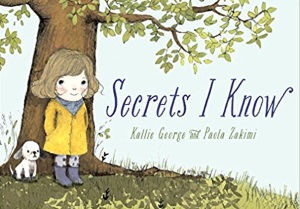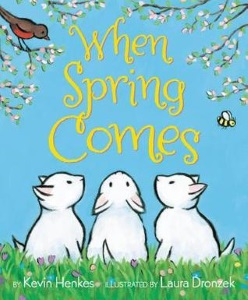2018 School Spending Survey Report
Spring news 2017 booklist
Here are some recent picture books perfect for springtime.
 Secrets I Know
Secrets I Knowby Kallie George; illus. by Paola Zakimi
Preschool Schwartz & Wade/Random 32 pp. g
5/17 978-1-101-93893-5 $17.99
Library ed. 978-1-101-93894-2 $20.99
e-book ed. 978-1-101-93895-9 $10.99
Whimsical text (“Secrets are for whispering”) and illustrations in muted colors convey the thoughtful interior life of a little girl’s day at play. She heads outside on a windy day with her yellow raincoat, her umbrella, and her lamb-like little dog, noticing that the sound of the blowing leaves is like “whispers hid[ing] in trees.” After waiting out a rain shower in a tree house, she floats her open umbrella in a puddle, and then sets up a pretend tea party in a sandbox, with seashells for cups and saucers. Each double-page spread holds just one phrase or sentence (occasionally, two), but the story is told largely through the illustrations, so children will linger to see what the girl and dog do next. Zakimi’s digitally colored pencil illustrations play with the thickness of lines to give texture. Toward the end, the little girl (who is white) visits with a brown-skinned friend, and the two return together to the tree house with a telescope to look at the sky: “Stars keep your secrets. They only tell the trees. And trees make great umbrellas. Which you already know.” This quiet picture book celebrates the joys of observation and old-fashioned playtime. SUSAN DOVE LEMPKE
From the May/June 2017 issue of The Horn Book Magazine.

by Kevin Henkes; illus. by the author
Preschool Greenwillow 40 pp.
1/17 978-0-06-240872-3 $17.99
Library ed. 978-0-06-240873-0 $18.89 g
In the latest offering from modern picture-book master Henkes (Waiting, rev. 9/15), we are introduced to four different eggs, each a different pastel color and each occupying its own separate quadrant of the page: “egg / egg / egg / egg.” The drama begins on the facing page — “crack / crack / crack / egg” — when three little chicks hatch, and the fourth egg…waits. The three hatchlings, concerned, gather ’round the egg and instigate a furious pecking campaign. Finally: “crack,” then “surprise!” What hatches from the fourth egg is not another chick. Will the other three reject the foundling (“alone / sad / lonely / miserable”), or embrace it? Henkes once again taps into the deepest emotions of preschoolers with the simplest of stories. This one contains a surfeit of humor despite the scarcity of text (there are just fifteen distinct words, though some repeat). Henkes manages to imbue his characters with heaps of personality and expression using just the slant of an eyebrow or the curve of a mouth (I particularly love team-leader pink chick assessing the unhatched egg, wings akimbo in concentration). Pacing is, as ever, perfect, taking full advantage of the switch from the early, snappy paneled pages to a series of wordless spreads that tell the story of the budding four-way friendship. And the ending is as trippy and open-ended as that of any in our established post-modernist picture books — it’s just preschool-sized. MARTHA V. PARRAVANO
From the January/February 2017 issue of The Horn Book Magazine.

by Kevin Henkes; illus. by Laura Dronzek
Preschool Greenwillow 40 pp.
2/16 978-0-06-233139-7 $17.99
Library ed. 978-0-06-233140-3 $18.89
“Before Spring comes, / the trees look like / black sticks against the sky. // But if you wait, / Spring will bring / leaves and blossoms.” In a gently rhythmic text and lush, vibrant paintings, this husband-and-wife author-illustrator team (Birds, rev. 3/09) ushers in spring, capturing the season’s sights, sounds, and surprises. With emphasis at first on waiting, Henkes’s poetic text focuses on details in which young children delight: the last snowman melting slowly away “until suddenly — [it’s] gone”; April showers — mud, puddles, and all (“I hope you like umbrellas”); pussy willows and new kittens. Likewise, Dronzek’s illustrations show a child’s-eye view of the world (and those white kittens have to be litter-mates of Henkes’s first-full-moon-admiring one). Her palette is a celebration of springtime hues, from earth tones and soft pastels to bright primary and secondary colors. Single pages, double-page spreads, and a few time-lapse sequences are satisfyingly varied. The narrative follows spring’s fickle progress, including an unexpected snowfall that weighs down some hopeful daffodils. Several stylistic devices (repetition, alliteration, line breaks) help create mood, and the page design perfectly marries text and art. “When Spring is finally here to stay,” the text teases that we’re not done waiting: “Now, you have to wait for Summer.” The back endpapers show what’s in store. This joyful reflection is as welcome as spotting the first brave crocus. KITTY FLYNN
From the March/April 2016 issue of The Horn Book Magazine.
 Flora and the Chicks: A Counting Book
Flora and the Chicks: A Counting Bookby Molly Idle; illus. by the author
Preschool Chronicle 22 pp.
3/17 978-1-4521-4657-7 $9.99
Flora (Flora and the Flamingo, rev. 7/13; Flora and the Penguin, rev. 11/14; Flora and the Peacocks, rev. 5/16) goes down on the farm in her first original board book outing, a wordless one-to-ten counting book (with numerals). Flora sees a hen sitting on her eggs. The hen, bleary-eyed, gets up and walks away from her nest (and, shown through Idle’s characteristically innovative use of page design and gatefolds, off the page). One by one, and in gently humorous fashion, the eggs start hatching; Flora, perhaps unwittingly, uses her dancer training (thanks, Flamingo!) to corral the adorable fluffy chicks: a leg extension here, a plié there, and balance, and reach. A little worm makes an appearance and a getaway, and Mama Hen returns. Idle incorporates details from previous Flora books—graceful poses, yellow daisies, the suggestion of background, a limited palette, though with a few more colors here—which will delight Flora’s young fans. ELISSA GERSHOWITZ
From the May/June 2017 issue of The Horn Book Magazine.
 Anywhere Farm
Anywhere Farmby Phyllis Root; illus. by G. Brian Karas
Primary Candlewick 32 pp.
3/17 978-0-7636-7499-1 $16.99 g
“For an anywhere farm, / here’s all that you need: / soil / and sunshine, / some water, / a seed.” Root’s upbeat Green Eggs and Ham–esque rhyming text details all the places one can grow things: “Plant a farm in a crate! / Plant a farm in a cup! / In a box on a balcony / ten stories up! / Plant a farm in a truck! / In a box on a bike! / Plant an anywhere farm / anywhere that you like.” The book then goes on to suggest what one might plant (“Kale in a pail. / Corn in a horn”) and who might come to visit one’s “anywhere farm” (bees, butterflies, birds — and neighbors). Karas’s mixed-media illustrations focus on one little girl who starts everything off with a single plant but eventually include a whole neighborhood that participates in transforming a barren urban space into a lush, flourishing garden. The diverse cast features a variety of skin colors as well as an infant-toting dad, a man in a wheelchair, and a bunch of pets; the group includes active children, old people content just to sit in a chair in the sunshine, and everyone in between. Inspiring and empowering; friendly and inviting. MARTHA V. PARRAVANO
From the March/April 2017 issue of The Horn Book Magazine.

by Lane Smith; illus. by the author
Preschool, Primary Roaring Brook 32 pp.
2/17 978-1-62672-536-2 $17.99
Just what is the definition of a perfect day? Well…it depends on your perspective. All the animals in Bert’s backyard are having the best day. Cat enjoys being in the flowerbed in the sunshine. “It was a perfect day for Cat.” Dog loves sitting in the wading pool. “It was a perfect day for Dog.” Bert fills Chickadee’s feeder and drops a few corncobs on the ground for Squirrel: perfect days for them as well. But then Bear arrives — whose idea of a perfect day flies directly in the faces of all the others. Bear bursts in from the left side, interrupting the quiet reverie. At first we see less than half a bear, but soon the enormous mammal fills the entire double-page spread. “It was a perfect day for Dog. It was a perfect day for Cat.” With the text using so few words (though, admirably, much repetition), Smith tells the story mostly through his textured mixed-media illustrations, which reflect each animal’s joy-filled frolic. In the end, it’s hard to blame Bear for breaking up the party — its glee is contagious as it rolls on the ground, gorging on chickadee food, playing in the wading pool, and making bear-angels in the flowerbed. ROBIN SMITH
From the January/February 2017 issue of The Horn Book Magazine.
 Spring for Sophie
Spring for Sophieby Yael Werber; illus. by Jen Hill
Preschool, Primary Wiseman/Simon 32 pp.
2/17 978-1-4814-5134-5 $17.99
e-book ed. 978-1-4814-5135-2 $10.99
In the middle of winter (a snowy, northern, rural winter), Sophie is ready for spring. She wonders when it will arrive and how she will know it is coming. Her mother tells her to listen for it. “When you hear the birds start to sing their songs to each other, that’s when you’ll know spring is coming. That’s what spring sounds like.” The gouache illustrations capture the intensity of Sophie’s listening: all through her daily activities, her head is cocked to one side; she’s concentrating. Eventually, she hears the first chirps, but it’s still cold and snowy. So her parents tell her to use her other senses to follow spring’s progress: she feels the changes in the frozen ground with her feet; sees the world gradually turn from white to green; smells the air. But in the end it’s Sophie herself who decides when spring has finally arrived: she runs outside and catches raindrops on her tongue. “Now I know spring is here…Because this is what spring tastes like!” The book progresses nicely through the change in seasons; double-page spreads of the landscape vary with pages of more action-filled vignettes. The happy busy-ness of a small child’s world — making paper snowflakes, reading, fetching the mail, playing with the family dog — is the secondary story here, recalling the child-centered picture books of Charlotte Zolotow or Eve Rice. MARTHA V. PARRAVANO
From the March/April 2017 issue of The Horn Book Magazine.
 Spring Hare
Spring Hareby Eugene Yelchin; illus. by the author
Preschool Holt 32 pp.
1/17 978-1-62779-392-6 $16.99
Yelchin presents a whimsical wordless tale brimming with energy. The story begins with a sequence of panels depicting a red-haired girl and a curious rabbit enjoying a romp on a trampoline. One particularly big bounce sends the child into the sky, leaving the watchful rabbit below; however, the rabbit soon springs up into the clouds after its friend. A series of progressively fanciful scenes unfolds, including: a hitched ride on a biplane, a run-in with a hot-air balloon, a race across a rainbow, and a trip to outer space, where Rabbit and the spacesuit-clad girl are finally reunited. A ride on a shooting star sends the rabbit back down to Earth, where the girl has landed on the trampoline. Readers may be left puzzled—did the outrageous events actually occur, or were they figments of the characters’ imaginations? Close looking might uncover a hint or two. Panoramic double-page spreads, along with a range of textures and a vibrant color palette, result in an immersive and buoyant bounce of an adventure. PATRICK GALL
From the March/April 2017 issue of The Horn Book Magazine.
![]()
RELATED
RECOMMENDED
ALREADY A SUBSCRIBER? LOG IN
We are currently offering this content for free. Sign up now to activate your personal profile, where you can save articles for future viewing.







Add Comment :-
Be the first reader to comment.
Comment Policy:
Comment should not be empty !!!